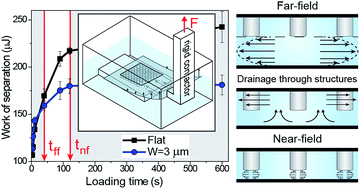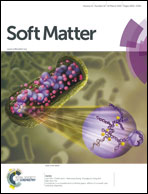Coupled effects of applied load and surface structure on the viscous forces during peeling†
Abstract
Tree frogs are able to take advantage of an array of epithelial cells in their toe pads to modulate their adhesion to surfaces under dry, wet, and flooded environments. It has been hypothesized that the interconnected channels separating the epithelial cells could reduce the hydrodynamic repulsion to facilitate contact under a completely submerged environment (flooded conditions). Using a custom-built apparatus we investigate the interplay between surface structure and loading conditions on the peeling force. By combining a normal approach and detachment by peeling we can isolate the effects of surface structure from the loading conditions. We investigate three surfaces: two rigid structured surfaces that consist of arrays of cylindrical posts and a flat surface as a control. We observe three regimes in the work required to separate the structured surface that depend on the fluid film thickness prior to pull out. These three regimes are based on hydrodynamics and our experimental results are compared with a simple scaling argument that relates the surface features to the different regimes observed. Overall we find that the work of separation of a structured surface is always less than or equal to that for a smooth surface when considering purely viscous contributions.


 Please wait while we load your content...
Please wait while we load your content...